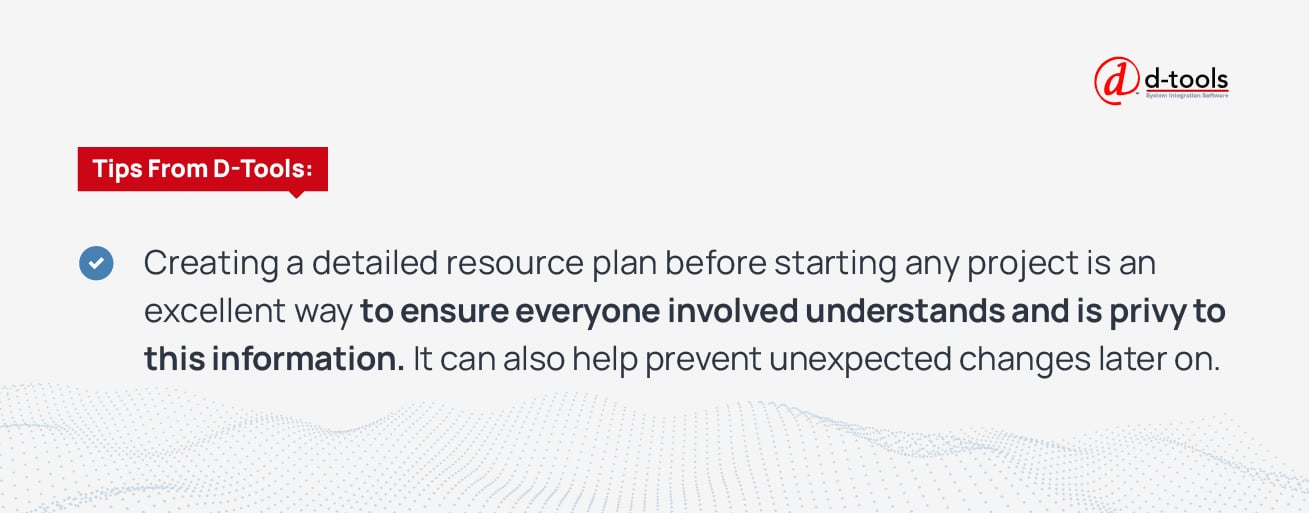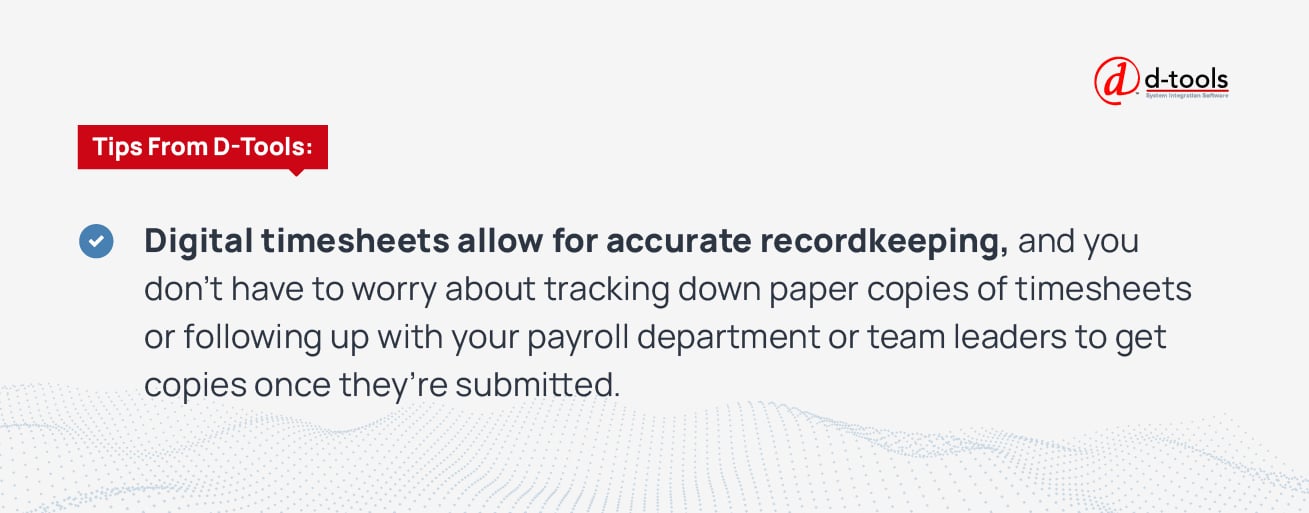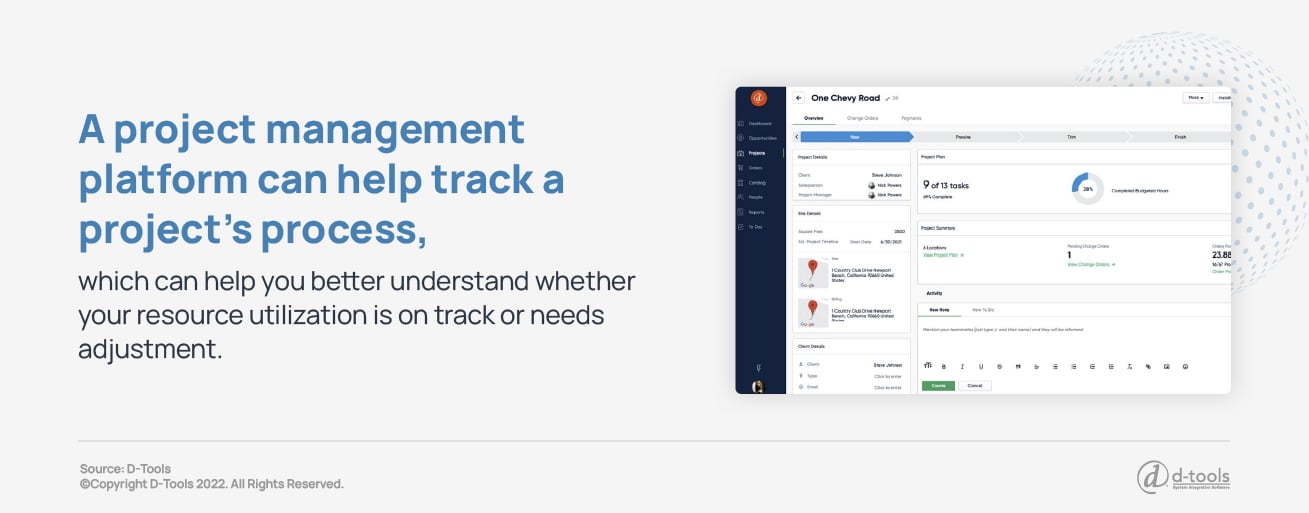Effective resource management is key to a project’s success. When done well, resource management can lead to increased profits, smoother project completion, and happier staff. But resource management is also a major challenge, especially when your company is working on multiple projects simultaneously.
To increase your chances for effective resource management across projects, It’s best to design and execute a repeatable process. Incorporating the resource management tips in this article can help ensure your process runs smoothly, and that you’re able to support each project successfully throughout its entire duration.
10 Tips for Effective Resource Management
As a project resource manager, you’ll need to effectively allocate people, budgets, inventory, and tools. Depending on the project, your resources might include staff time, finances, products, supplies, company vehicles, and more. That’s a lot to track, but these 10 tips can help make the process more manageable.
1. Start with a Resource Plan
Before any project starts, take the time to create a detailed resource plan. This plan will guide your resource management through the entire project, and it gives you the foundation of information you need to effectively manage project resources. 
Your resource plan needs to detail all the resources a project will require during its lifespan. During this project planning phase, you’ll need to sit down with team leaders, establish a budget, and identify any resource limitations that might pose challenges. Together, you’ll outline the core aspects of the project, including goals, milestones, and deadlines.
This is an excellent way to ensure everyone involved understands and is privy to this information. It can also help prevent unexpected changes later on.
2. Determine How to Prioritize Projects and Resources
In addition to creating a resource plan, you’ll need to determine how to prioritize projects and resources within the business. This discussion should be a continuation of your discussion with team leaders. It might also need to involve your CEO or other upper-level management.
During this discussion, determine how projects will be prioritized over others. This is particularly important if you have multiple projects occurring simultaneously, and if those projects utilize the same resources, like staff time.
Establishing prioritization policies ahead of time can help you successfully navigate challenges as they arise. For example, if multiple projects depend on the same limited number of resources, you’ll have guidance to rely on when it comes to allocating those resources and either restaffing or rescheduling projects as needed.
>> Related Read: 8 Field Service Challenges and How to Overcome Them
3. Establish Team Collaboration
Staff collaboration can build team rapport, increase workforce productivity, and even help prevent miscommunication and issues with missed deadlines or other project obstacles. Since staff who collaborate well tend to be more productive, encouraging this collaboration also can help increase your staff time resource.
A quality project management tool can help foster staff collaboration. Look for a platform that lets staff engage, update, and communicate in a central location. Tools that offer real-time interactions can help unite staff, even if they’re working remotely or in different locations. A platform that creates a running record of these interactions adds an extra layer of accountability, ensuring everyone is apprised and working together toward the same goal.
4. Implement Accurate Time-Tracking Measures
Staff time is one of the most essential resources for any project, so be sure you are able to track time accurately. Establishing a reliable, digital way to track time is important for accuracy.

It’s best to implement a digital time-tracking practice that allows you to see how much time staff are dedicating to any given project and how much of their time is dedicated to other work. Digital timesheets allow for accurate recordkeeping, and you don’t have to worry about tracking down paper copies of timesheets or following up with your payroll department or team leaders to get copies once they’re submitted.
When you track time digitally, your records will also be up to date. You can even ask staff to track time daily, so there’s no delay in your ability to review the data. This prompt data access means you can review staff resource management weekly (or daily) to monitor staff time utilization. If under- or over-utilization occurs, you’ll be aware of the issue early on and can take steps right away to address the problem.
>> Related Read: Field Service Time Tracking Done Right
5. Establish Communication with Staff
Staff communication plays multiple roles in your resource management capabilities. Establishing lines of communication with your team ensures you’ll receive prompt updates about project obstacles, changing resource needs, and other essential information.
But staff communication goes beyond keeping you updated. As you get to know the members of the team more, you’ll learn about the types of work they find most rewarding and engaging. The more you understand their preferences and work styles, the better you can utilize their talents in your current and future projects. Strategically assigning staff work that they enjoy can also help boost morale and keep staff personally invested in projects and their success.
It’s also essential to communicate with the team about how they’re handling their workloads. While project management software can give you detailed information about the tasks and workflows that staff are performing, establishing a personal connection can alert you to conflicts or challenges of which you might not have otherwise been aware. Checking in with team members to ensure their workloads are appropriate positions your team to successfully complete their work for the project on time, keeping the overall project on task.
6. Implement Detailed Resource and Project Tracking

To successfully manage resources, it’s important to have a way to track not only staff utilization, but also the project’s progress. This is often best accomplished with project management software.
Look for a software platform that lets you and other team members see project progress at a glance. A broad overall view is helpful, but equally important is the ability to access more nuanced views that include staff milestones and workflows. Being able to see exactly which phase a project is in can help you better understand whether your resource utilization is on track or needs adjustment.
In addition, integrated timesheet tracking, as well as the ability to monitor budgets, expenses, and physical resources in one space helps to make this utilization tracking easier. Automating some of these tracking processes, like expense tracking, can also help to avoid human errors and miscalculations, ensuring the data you’re working with is accurate and up to date.
>> Schedule a Guided Tour of D-Tools’ Project Management Software Today
7. Plan for When Things Go Wrong
It’s inevitable that, at some point during a project, things will go wrong. The more you can plan for problems and be prepared to fix them, the faster you’ll be able to get the project back on track. You may be able to bank extra resources as a sort of backup plan for these types of problems, but if that isn’t possible, establish a process that will help you address and fix issues when they arise. That process might involve an emergency team meeting with project leads and management — whatever it looks like, establish that plan ahead of time so you can implement it quickly if and when needed.
8. Approach Resource Management as a Long Game
Most importantly, stay vigilant with your resource management throughout the entire duration of a project. Even in the last stages of a project, things can change and additional resources may be needed. Keeping all your records updated and monitoring the project’s progress ensures you’ll be prepared to respond to these needs at any time.
9. Think About Future Projects
Seeing resource management through to the end can also help you to prepare for other projects. Reflecting back on the resources that were needed versus what was allocated can provide important lessons that will better inform your future planning, helping future projects to go more smoothly.
As you wrap up projects, don’t forget to look ahead to the projects that are coming. Knowing certain staff have excelled with particular project tasks can help you strategically assign them to roles with future projects where they’re also likely to succeed.
>> Related Read: The Ultimate Guide to Project Management
10. Use the Right Project Management Software
Quality project management software can contribute to your resource management success in multiple ways. With the right software platform, you’ll be able to access all of the information you need right within a central location. Digitizing processes, including workflow tracking and time tracking, means you can view this data instantly, and it also helps to reduce errors and omissions that could spell trouble for resource allocation and budgeting.
D-Tools Cloud and System Integrator offer the capabilities you need to effectively support project and resource management through the initial planning stages through project completion and assessment. Both software solutions feature project planning tools for resource management, scheduling, time tracking, and more.
>> Next Step: Find Out Which D-Tools Software Solution Is Right for You






